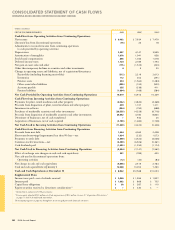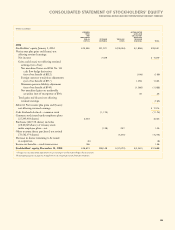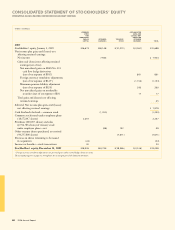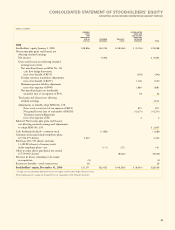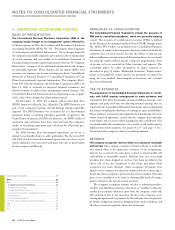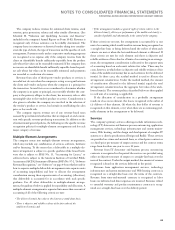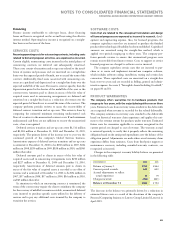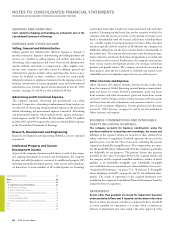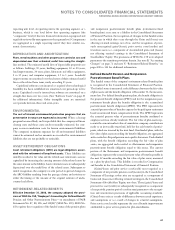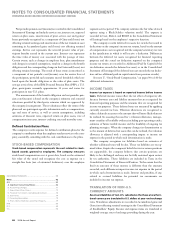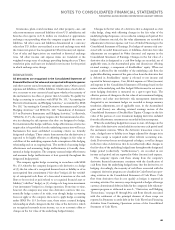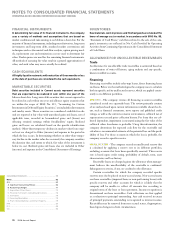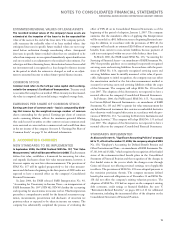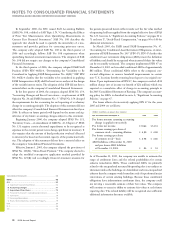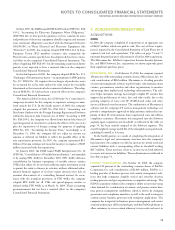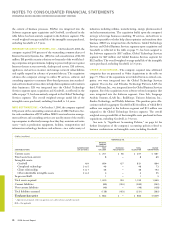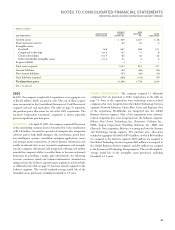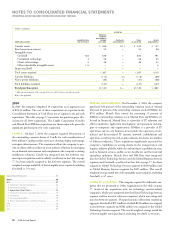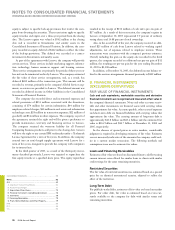IBM 2006 Annual Report Download - page 70
Download and view the complete annual report
Please find page 70 of the 2006 IBM annual report below. You can navigate through the pages in the report by either clicking on the pages listed below, or by using the keyword search tool below to find specific information within the annual report.
Net periodic pension cost/(income) is recorded in the Consolidated
Statement of Earnings and includes service cost, interest cost, expected
return on plan assets, amortization of prior service cost and (gains)/
losses previously recognized as a component of Gains and (losses) not
affecting retained earnings and amortization of the net transition asset
remaining in Accumulated gains and (losses) not affecting retained
earnings. Service cost represents the actuarial present value of par-
ticipant benefits earned in the current year. Interest cost represents
the time value of money cost associated with the passage of time.
Certain events, such as changes in employee base, plan amendments
and changes in actuarial assumptions, result in a change in the benefit
obligation and the corresponding change in the Gains and (losses) not
affecting retained earnings. The result of these events is amortized as
a component of net periodic cost/(income) over the service lives of
the participants, provided such amounts exceed thresholds which are
based upon the benefit obligation or the value of plan assets. The
average service lives of the IBM Personal Pension Plan (PPP), a U.S.
plan, participants currently approximates 11 years and varies for
participants in non-U.S. plans.
The measurement of the benefit obligation and net periodic pen-
sion cost/(income) is based on the company’s estimates and actuarial
valuations provided by third-party actuaries which are approved by
the company’s management. These valuations reflect the terms of the
plans and use participant-specific information such as compensation,
age and years of service, as well as certain assumptions, including
estimates of discount rates, expected return on plan assets, rate of
compensation increases, interest crediting rates and mortality rates.
Defined Contribution Plans
The company records expense for defined contribution plans for the
company’s contribution when the employee renders service to the com-
pany, essentially coinciding with the cash contributions to the plans.
STOCK-BASED COMPENSATION
Stock-based compensation represents the cost related to stock-
based awards granted to employees. The company measures
stock-based compensation cost at grant date, based on the estimated
fair value of the award and recognizes the cost as expense on a
straight-line basis (net of estimated forfeitures) over the employee
requisite service period. The company estimates the fair value of stock
options using a Black-Scholes valuation model. The expense is
recorded in Cost, SG&A, and RD&E in the Consolidated Statement
of Earnings based on the employees’ respective function.
The company records deferred tax assets for awards that result in
deductions on the company’s income tax returns, based on the amount
of compensation cost recognized and the company’s statutory tax rate
in the jurisdiction in which it will receive a deduction. Differences
between the deferred tax assets recognized for financial reporting
purposes and the actual tax deduction reported on the company’s
income tax return are recorded in Additional Paid-In Capital (if the
tax deduction exceeds the deferred tax asset) or in the Consolidated
Statement of Earnings (if the deferred tax asset exceeds the tax deduc-
tion and no additional paid-in capital exists from previous awards).
See note U, “Stock-Based Compensation,” on pages 96 to 100 for
additional information.
INCOME TAXES
Income tax expense is based on reported income before income
taxes. Deferred income taxes reflect the tax effect of temporary dif-
ferences between asset and liability amounts that are recognized for
financial reporting purposes and the amounts that are recognized for
income tax purposes. These deferred taxes are measured by applying
currently enacted tax laws. Valuation allowances are recognized to
reduce deferred tax assets to the amount that will more likely than not
be realized. In assessing the need for a valuation allowance, manage-
ment considers all available evidence including past operating results,
estimates of future taxable income and the feasibility of ongoing tax
planning strategies. When the company changes its determination as
to the amount of deferred tax assets that can be realized, the valuation
allowance is adjusted with a corresponding impact to income tax
expense in the period in which such determination is made.
The company recognizes tax liabilities based on estimates of
whether additional taxes will be due. These tax liabilities are recog-
nized when, despite the company’s belief that its tax return positions
are supportable, the company believes that certain positions are
likely to be challenged and may not be fully sustained upon review
by tax authorities. These liabilities are included in Taxes in the
Consolidated Statement of Financial Position. To the extent that the
final tax outcome of these matters is different than the amounts
recorded, such differences impact income tax expense in the period
in which such determination is made. Interest and penalties, if any,
related to accrued liabilities for potential tax assessments are
included in income tax expense.
TRANSLATION OF NON-U.S.
CURRENCY AMOUNTS
Assets and liabilities of non-U.S. subsidiaries that have a local func-
tional currency are translated to U.S. dollars at year-end exchange
rates. Translation adjustments are recorded in Accumulated gains and
(losses) not affecting retained earnings in the Consolidated Statement
of Stockholders’ Equity. Income and expense items are translated at
weighted-average rates of exchange prevailing during the year.
NOTES TO CONSOLIDATED FINANCIAL STATEMENTS
INTERNATIONAL BUSINESS MACHINES CORPORATION AND SUBSIDIARY COMPANIES
68 2006 Annual Report
Consolidated Statements .........................................................
Notes .....................................................................................
A-G ......................................................................................... 62
A. Significant Accounting Policies ....................................... 62
B. Accounting Changes........................................................ 71
C. Acquisitions/Divestitures ................................................. 73
D. Financial Instruments (excluding derivatives) ................ 78
E. Inventories ....................................................................... 79
F. Financing Receivables ...................................................... 79
G. Plant, Rental Machines and Other Property ................... 79
H-M ......................................................................................... 80
N-S .......................................................................................... 88
T-X .......................................................................................... 96
Black
MAC
390 CG10


